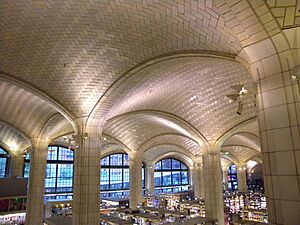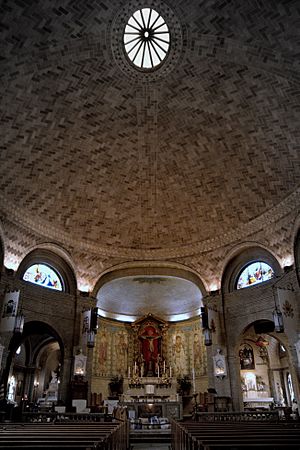Rafael Guastavino facts for kids
Quick facts for kids
Rafael Guastavino
|
|
|---|---|

Portrait of Rafael Guastavino
|
|
| Born |
Rafael Guastavino Moreno
March 1, 1842 |
| Died | February 1, 1908 (aged 65) |
| Resting place | Basilica of St. Lawrence, Asheville |
| Engineering career | |
| Discipline | Architectural engineering |
| Significant advance | Guastavino tile |
Rafael Guastavino Moreno (born March 1, 1842 – died February 1, 1908) was a talented Spanish engineer and builder. He moved to the United States in 1881 and became famous for his building methods in New York City.
Rafael Guastavino developed a special way of building called the "Tile Arch System." This system was based on an old Spanish building style called the Catalan vault. He got a patent for his system in the United States in 1885. It used special interlocking terracotta tiles and layers of mortar to create strong, self-supporting arches and vaults. His unique tiles, known as Guastavino tiles, can be seen in many important buildings across the United States.
Contents
Guastavino's Building Company
In 1881, Guastavino arrived in New York City from Valencia, Spain, with his young son, Rafael III. He was already a skilled architect in Spain. One of his first big jobs in the U.S. was working on the Dakota Apartment House in New York, which was finished in 1884. He was in charge of making the building fireproof.
His reputation grew after he worked on the Boston Public Library in 1889. This project helped him become known to many important architects on the East Coast. Later, in 1890, he partnered with William Blodgett and was hired by George W. Vanderbilt. Vanderbilt wanted him to build arches for his new mansion, the Biltmore Estate, in Asheville, North Carolina.
After working on the Biltmore Estate, Guastavino decided to build his own home nearby. He chose a large valley in Black Mountain, North Carolina. His property, called Rhododendron, had a vineyard, a dairy, and even a brick kiln. Today, this land is owned by Christmount Assembly. You can still see parts of his old property, like the kiln, a wine cellar, and stone walls.
Rafael Guastavino and his son received twenty-four patents for their building ideas. Their company, the Guastavino Fireproof Construction Company, was started in 1889. Rafael Jr. took over the company after his father. The company continued to work on projects until 1962. They even created a special sound-absorbing material called Akoustolith.
Hundreds of major buildings across the country feature the distinctive Guastavino Tile Arch System. For example, in Chicago, the Rockefeller Chapel at the University of Chicago used 100,000 Guastavino tiles. In Boston, you can find them in the Boston Public Library.
Famous Buildings with Guastavino Tiles
Many famous buildings in New York City use Guastavino tiles. These include Grand Central Terminal, Grant's Tomb, Carnegie Hall, the American Museum of Natural History, and St. Bartolomew's Episcopal Church. In Washington, D.C., his tiles are in the U.S. Supreme Court building and the National Museum of Natural History. The domes of Philadelphia's St. Francis de Sales Roman Catholic Church are also made with Guastavino tiles. You can also see them in Pittsburgh's Union Station and the Nebraska State Capitol.
Guastavino's Work in New York City

In 1900, Guastavino helped build the City Hall subway station in New York. This station was meant to be a beautiful showpiece for the new New York City Subway. Although it was elegant, it was not very practical for daily use and closed in 1945. Guastavino also installed the ceiling of the south arcade of the Manhattan Municipal Building.
The Guastavino family arrived in New York as immigrants through Ellis Island. In 1917, Rafael Guastavino III (the son) was asked to rebuild the ceiling of the Great Hall at Ellis Island. He used 28,832 tiles to create a strong, self-supporting ceiling that was 56-foot (17 m) high. It was so durable that when the building was restored in the 1980s, only seventeen tiles needed to be replaced!
The largest dome built by the Guastavino Company is at the Cathedral of St. John the Divine in Manhattan. This dome is 100 ft (30 m) wide and 160 feet (49 m) high. It was originally meant to be a temporary structure. However, it proved so strong and well-built that it is still there today, over 100 years later. Guastavino won this job because his system was much cheaper. His method allowed masons to work from above, building on the previous day's work without needing expensive scaffolding.
Buildings Designed by Guastavino
Rafael Guastavino mostly worked on parts of buildings, like ceilings and arches. But he also designed some complete structures himself. He designed a series of unique rowhouses on West 78th Street in Manhattan, known for their special "red and white" Moorish style. Another building he designed is now an event space called Guastavino's, located under the Queensboro Bridge in Midtown Manhattan. His son, Rafael III, also designed his own home, a Mediterranean-style villa built entirely of Guastavino tiles in Bay Shore, Long Island. This house was added to the National Register of Historic Places in 2013.
Guastavino's Retirement in North Carolina

After finishing his work at the Biltmore Estate, Guastavino retired to Black Mountain, North Carolina. His former estate is now Christmount, a conference center. You can still visit the ruins of his original estate and see a collection of his belongings in the Christmount library. His estate was added to the National Register of Historic Places in 1989.
Guastavino also completed several projects in North Carolina. His work can be found in Duke Chapel in Durham, the Jefferson Standard Building in Greensboro, and the Basilica Shrine of St. Mary in Wilmington. He designed the Basilica of St. Lawrence, Asheville in 1905, and he is buried in its crypt.
Images for kids
See also
 In Spanish: Rafael Guastavino para niños
In Spanish: Rafael Guastavino para niños








